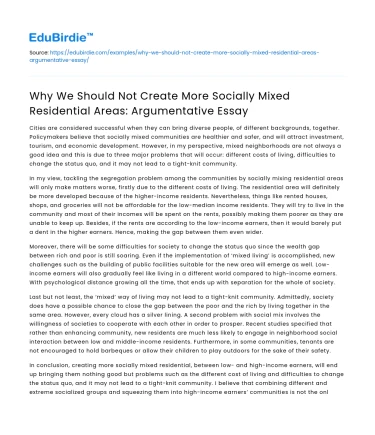Cities are considered successful when they can bring diverse people, of different backgrounds, together. Policymakers believe that socially mixed communities are healthier and safer, and will attract investment, tourism, and economic development. However, in my perspective, mixed neighborhoods are not always a good idea and this is due to three major problems that will occur: different costs of living, difficulties to change the status quo, and it may not lead to a tight-knit community.
In my view, tackling the segregation problem among the communities by socially mixing residential areas will only make matters worse, firstly due to the different costs of living. The residential area will definitely be more developed because of the higher-income residents. Nevertheless, things like rented houses, shops, and groceries will not be affordable for the low-median income residents. They will try to live in the community and most of their incomes will be spent on the rents, possibly making them poorer as they are unable to keep up. Besides, if the rents are according to the low-income earners, then it would barely put a dent in the higher earners. Hence, making the gap between them even wider.
Save your time!
We can take care of your essay
- Proper editing and formatting
- Free revision, title page, and bibliography
- Flexible prices and money-back guarantee
Moreover, there will be some difficulties for society to change the status quo since the wealth gap between rich and poor is still soaring. Even if the implementation of ‘mixed living’ is accomplished, new challenges such as the building of public facilities suitable for the new area will emerge as well. Low-income earners will also gradually feel like living in a different world compared to high-income earners. With psychological distance growing all the time, that ends up with separation for the whole of society.
Last but not least, the ‘mixed’ way of living may not lead to a tight-knit community. Admittedly, society does have a possible chance to close the gap between the poor and the rich by living together in the same area. However, every cloud has a silver lining. A second problem with social mix involves the willingness of societies to cooperate with each other in order to prosper. Recent studies specified that rather than enhancing community, new residents are much less likely to engage in neighborhood social interaction between low and middle-income residents. Furthermore, in some communities, tenants are not encouraged to hold barbeques or allow their children to play outdoors for the sake of their safety.
In conclusion, creating more socially mixed residential, between low- and high-income earners, will end up bringing them nothing good but problems such as the different cost of living and difficulties to change the status quo, and it may not lead to a tight-knit community. I believe that combining different and extreme socialized groups and squeezing them into high-income earners’ communities is not the only way to end segregation and inequality.






 Stuck on your essay?
Stuck on your essay?

